Pet rabbit welfare guidance
This document provides detailed information about the needs of pet rabbits and how to meet these needs in accordance with good practice.
Section 7: The need to be protected from suffering, injury and disease
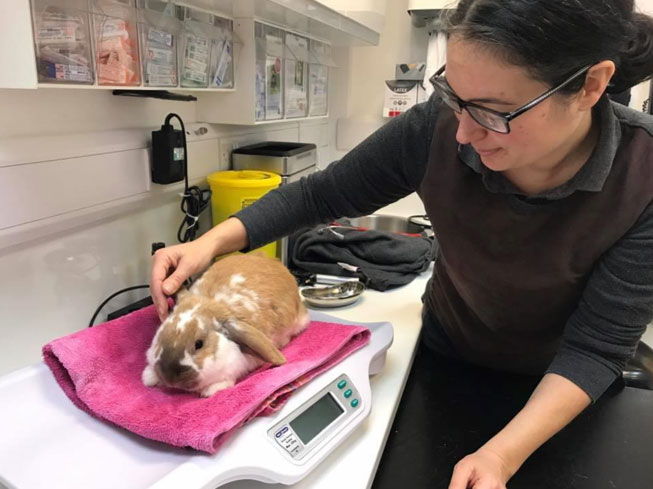
Health care
As the person responsible for your rabbits' welfare you should consider:
- Prevention of disease: there are annual vaccines that are designed to protect rabbits from diseases such as Myxomatosis and Viral Haemorrhagic Disease (including the new strain VHD2). Both of these diseases are usually fatal and your rabbits should be vaccinated. Your veterinary surgeon can provide information on the prevention of other diseases, depending on whether your rabbits are indoor or outdoor rabbits.
- Provision of a healthy balanced diet (see Section 4)
- Provision of the right environment that minimises the risk of injury and disease, and allows your rabbits to perform all their natural behaviours (see Sections 3 and 5)
- Prompt action if a rabbit becomes ill, is injured or in pain, or shows a change in its behaviour
- Observation and handling your rabbits daily
- Regular check-ups with your vet.
Your vet is best placed to advise you about routine health care for your rabbits, such as neutering, vaccination, internal and external parasite control as well as any health problems your rabbits may have. You may wish to consider taking out pet insurance, to cover any unexpected vet bills.
The Rabbit Welfare Association and Fund ( RWAF) produces a list of veterinary practices which demonstrate a good knowledge of rabbit care. You can find the nearest one to you by visiting the RWAF website and entering your postcode: https://rabbitwelfare.co.uk/rabbit-welfare-association-fund/our-work/rabbit-friendly-vets/rabbit-friendly-vet-list/. In addition to those on the RWAF list, a number of unlisted Scottish veterinary surgeries also provide care for rabbits, and can be found through an internet search.
Suffering
You should be aware of the signs that indicate your rabbits are not well, and consult a vet if your rabbits show any signs of illness, injury, pain or a change in their behaviour.
Rabbits are prey animals and, to avoid attracting attention from predators, they often do not look ill until they are very unwell. It is important that you get to know your rabbits and familiarise yourself with their normal behaviour, so you can spot any subtle changes. They can become worse very quickly, so you need to act promptly. If your rabbit is not eating or not passing faeces, this should be treated as an emergency requiring immediate veterinary attention.
Indications of suffering may include:
- a change in behaviour, such as:
- sitting still in hunched posture;
- becoming apprehensive, anxious or aggressive;
- increases in activity (ie restlessness) or decreases in activity (ie apathy);
- increases in struggling when handled;
- increases in abnormal behaviour (eg fur pulling, chewing parts of shelter etc);
- scratching, licking or tooth grinding;
- changes in respiratory rate (ie laboured or hyperventilation);
- excessive scratching, licking or biting of areas of the body;
- over-reaction to people (ie increased attempts to hide, attempts to escape etc);
- a change in appearance, such as:
- pale eyes;
- generally dull appearance;
- unkempt due to lack of grooming / fur standing on end;
- excessive grooming leading to baldness and sore patches;
- dilated pupils;
- flattened ears;
- potential signs of abdominal pain, such as:
- increased guarding of body areas to prevent them being touched;
- flinching or full body flexing (jerking upwards for no apparent reason);
- squealing / crying;
- twitching (rapid movement of fur on back);
- belly pressing (pressing stomach into the floor);
- writhing (contraction of sides of the abdomen / flanks);
- abnormal locomotion (eg staggering, shuffling or abnormal walking or hopping);
- falling over unexpectedly when moving;
- wincing / drawing back (rapid backwards movement in rocking motion);
- back arching (arching upwards and contracting stomach);
- tucked abdomen;
- reluctance to rear up on hind legs;
- a change in eating and drinking habits, such as increased or decreased appetite or thirst;
- a change in droppings: smaller, darker, fewer, runny or none;
- uneaten caecotrophs;
- signs of injury such as a swollen limb, guarding or limping;
- signs of disease such as a discharge from the eye, ear or nose, difficulty in going to the toilet or diarrhoea;
- drooling or staining on the chin or chest;
- difficulties in breathing, especially if your rabbit is trying to breathe through its mouth rather than its nose;
- redness of skin around belly, bottom or on underside of feet;
- difficulty in feeding and / or drinking.
The sources of these indicators can be found in Appendix 3.
The pictures below show some of the ways your rabbits might behave if they are in pain.
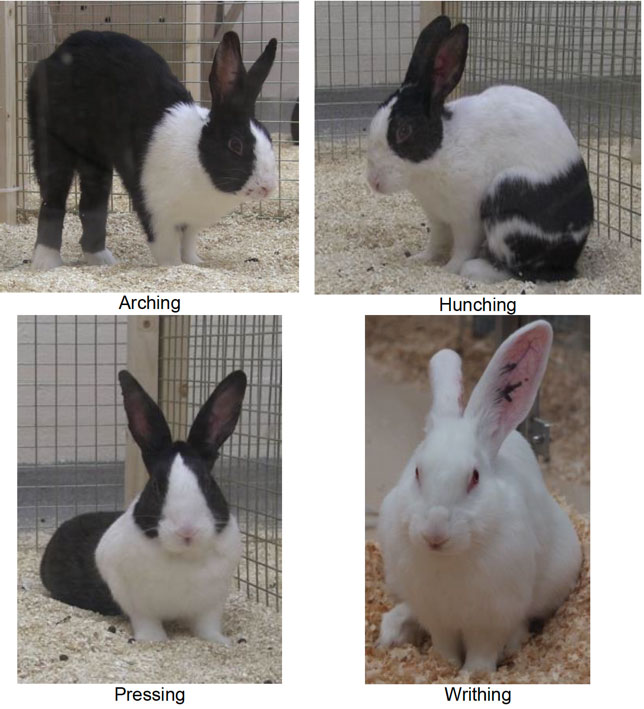
Changes in your rabbit's facial expression may also be a sign that it may be in pain. The following pictures (known as a 'Grimace Scale') show some signs to look out for . As this scale is still under development, we advise that it should be used alongside the other indicators set out above, rather than in isolation. It should also only be used when your rabbit is fully awake.
This scale was developed by the Pain & Animal Welfare Sciences ( PAWS) group at Newcastle University. Further information on this grimace scale can be found in Appendix 3.
You should consult your vet if your rabbit is showing any signs that it is in pain.
Orbital tightening
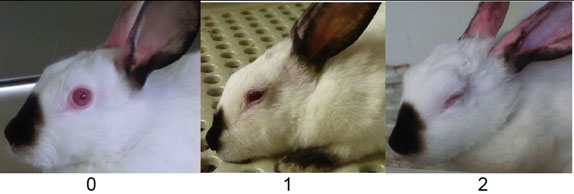
- Closing of the eyelid (narrowing of orbital area)
- A wrinkle may be visible around the eye
Cheek Flattening
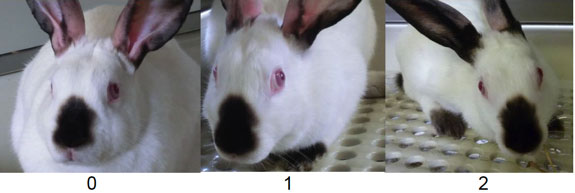
- Flattening of the cheeks to take on a sunken look
- Face becomes more angular and less rounded
Nostril Shape
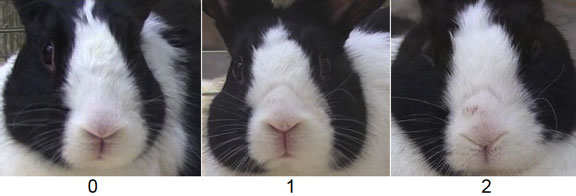
- Drawn vertically forming a 'V' rather than 'U' shape
- Nose tip is moved down towards the chin
Ear shape/position

- Become tightly folded/curled (more cylindrical) in shape
- Rotate from facing sound to facing hindquarters
- May be held closer to the back or sides of the body
Whisker change

- Pushed away from face to 'stand on end'
- Stiffen and lose their natural downward curve
- Increasingly point in the same direction
Routine Health Check
You should check your rabbits regularly for signs of ill health, and consult your vet if you find any. Listed below are the main health checks you should undertake. It is important that anyone caring for your rabbits understands the importance of these checks, and that daily care is about more than simply feeding, watering and cleaning.
Daily Checks
- Behaviour – watch your rabbits at least once a day to ensure they are behaving normally as well as eating and drinking their usual amount.
- Feet – check for bald patches and sores.
- Fur – check for parasites, dandruff, patches of baldness, itchy sores, scaly patches, damp or weeping patches and wounds.
- Eyes – ensure they are clear and not weeping. Runny eyes are often signs of respiratory infection which can easily turn into pneumonia.
- Nose – ensure it is not runny. A runny nose is often a sign of respiratory infection which can easily turn into pneumonia.
- Mouth – rabbits are obligatory nose breathers, so any sign that they are attempting to breathe through their mouth is a sign that they are having trouble breathing through their nose and should be treated as an emergency. Also check for a wet chin or drooling. As rabbits are very clean animals it may not be easily spotted. However, the fur on their chest and front paws may be stained with drool which can be a sign of a painful mouth, and should be checked by your vet.
- Ears – check for crusty wax, lumps around the ears, excessive scratching, scratch marks, scabs or flaky skin, head shaking or odours.
- Droppings – check they have not changed in appearance or reduced in number
- Bottom and tail – check your rabbits' bottoms, and around the tail area, as well as the floor of its living area, for signs of diarrhoea or maggots. A rabbit with diarrhoea or maggots should be seen by a vet immediately.
- Body – check for any lumps
Weekly checks
- Nails – check that they are an appropriate length and not damaged.
- Teeth – ensure that incisors are an appropriate length and shape.
Fly Strike
During warm weather, rabbits should be checked at least twice daily underneath and around the bottom and tail area for droppings stuck in their fur. Having a dirty bottom can increase the risk of a condition known as "fly strike" which can kill a rabbit in a matter of hours. Fly strike occurs when flies lay their eggs in the rabbit's dirty fur. The hatched maggots eat into the rabbit's flesh, causing severe damage and releasing toxins. This may produce shock, severe illness and even death.
You should contact your vet immediately if you find maggots on your rabbits.
If one of your rabbits is having problems with soiling itself you should:
- ensure its fur is clean
- ensure the floor of its living area is clean
- ensure there is plenty of fibre (such as hay or fresh grass, but not lawnmower clippings) in your rabbits' diet
- reduce the amount of vegetables and fruit in the diet
- seek veterinary advice immediately
Weight
It is a good idea to check and record your rabbits' weight at least once a month. Loss of weight may indicate a dental or other health problem. Being overweight or obese will cause your rabbits to suffer. Potential problems may include:
- painful stress on their joints
- sore feet
- a decreased ability to exercise
- heat stress
- inadequate diet as they are unable to reach to catch the soft pellets from their bottom that they need to eat in order to get all the goodness from their food
- fly strike as the rabbit cannot clean itself properly
Grooming
Rabbits naturally moult at the end of the winter and summer but our varying temperatures, as well as central heating, means that many rabbits are constantly moulting (shedding fur). Regular grooming is needed to keep your rabbits comfortable and prevent them swallowing lots of fur when they clean themselves as this can cause a blockage of the gut. Rabbits with a short coat should be groomed weekly but longhaired rabbits should be groomed at least once a day to avoid matting and tangles. Longhaired rabbits can also be clipped by a vet or pet care specialist.
Nails
Your rabbits' nails should be kept at an appropriate length, and should not protrude much further than the fur on the feet. Rabbits' nails wear down naturally when they exercise on harder surfaces or when digging. How often your rabbits' nails need to be trimmed depends on where your rabbit is kept. If you are concerned about your rabbits' nails, you should consult your vet.
Dental Care
Your rabbits' teeth will grow continuously throughout their life. Dental health relies on a diet high in hay and grass which will wear down their teeth as they chew.
Check your rabbits' front teeth to make sure that they are not misaligned or overgrown. Some breeds of rabbit are more prone than others to having dental problems because of the way their skulls are formed. Only a vet should correct misaligned or overgrown teeth. It is sensible to ask your vet to check teeth at your annual check-up, but if you spot anything unusual in between check-ups, you should consult your vet straight away
Back teeth can be misaligned and grow sharp spurs which can cause severe pain to your rabbits when they eat. They cannot be seen easily and should be checked by your vet by otoscope exam, ideally every 6 months. If a more in-depth examination requiring sedation or anaesthesia is needed your vet should be able to advise you.
Dental problems can cause a poor appetite, a wet chin or drooling. Your rabbit might be in a lot of pain and might stop eating completely. If your rabbits are showing any of these symptoms you should take them to see your vet immediately.
Neutering
One particularly important consideration is getting your rabbits neutered. This will not only prevent any unwanted baby rabbits but provides other advantages. Rabbits that are not neutered may develop problematic behaviour and may also suffer health problems.
If a female rabbit is not neutered she can:
- be aggressive to other rabbits
- try to make a nest by excessive digging, which can damage her nails
- have a risk of developing a life-threatening womb infection or, more commonly, cancer
- have phantom pregnancies, which can be emotionally frustrating and cause the rabbit to pluck her fur to make a nest. Nests should not be disturbed or removed until the phase has passed as the rabbit will continue to pluck fur from her chest area to build another.
If a male rabbit is not neutered he can:
- be aggressive to other rabbits
- spray urine
- mount other rabbits and animals
- (more rarely) develop testicular infections or cancer.
(Points 1-3 above can also be part of normal rabbit behaviour. However, some rabbits may exhibit excessive troublesome behaviours, and neutering may reduce these activities.)
Rabbits are very sociable animals, and should be provided with a companion (see Section 6). Animals that have not been neutered might not be able to be kept with other rabbits. The age when rabbits can be neutered varies with the rabbit's gender and breed. Females are usually neutered when they reach sexual maturity at the age of 4 months and males at the age of 3 months.
Allowing your rabbits to breed is not recommended, given the numbers of domestic rabbits that are already in need of homes. However, if you are considering breeding from your rabbits, you need to make sure that the welfare needs of the parents and their potential offspring are met. Consult your vet as necessary. You should ensure you have found suitable homes for the baby rabbits and you should avoid unplanned pregnancies.
From the age of 4 months, a female rabbit can produce between 2 to 12 babies per litter (an average of 5-8), and can become pregnant again soon after she has given birth. If kept with an un-neutered male, the female may have 6 litters a year, potentially 72 babies.
The pros and cons of whether to neuter your rabbits, as well as timing, should be discussed with your vet.
Wild Rabbits
Your rabbits should not have contact with wild rabbits or areas where wild rabbits have been because of the risk of disease spread.
Medication
Some medicines used for humans and other animals can be very dangerous to rabbits. Only use medicines that have been specifically prescribed or recommended for your rabbits by a vet.
Identification
You should not allow your rabbits to escape. However, it is a good idea to permanently identify your rabbits with a microchip just in case they do get out. Microchipping should only be done by a suitably qualified person, eg a veterinary surgeon. It is important that your contact details are kept up to date on the microchip database.
What to do if one of your rabbits is missing
You should contact local authority animal wardens, vets and local animal rescue centres. You can also put notices in local shops or newspapers, and use social media to ask people to look out for your rabbit. Once your rabbit has been found any notices that you have put up should be removed.
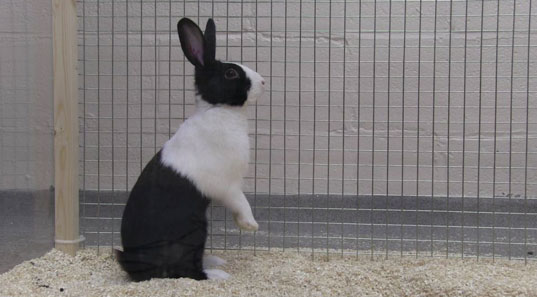
Contact
There is a problem
Thanks for your feedback